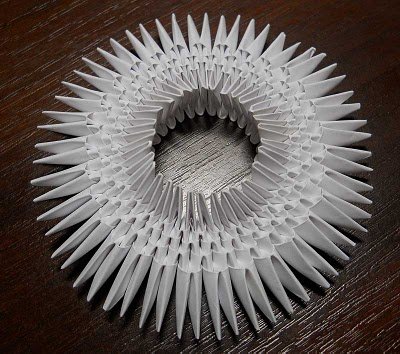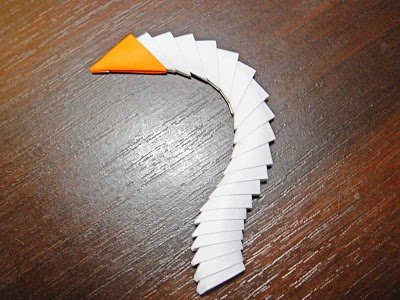
Origami is not only a hobby, but also a way to add coziness and uniqueness to the house. Paper figurines are cheaper than figurines and paintings, but no decoration from the store brings its owner so much pleasure from the awareness of the forces invested in the work. The admiring glances of the guests are the best compliment to the hostess. In this article we will tell you how to make a swan out of paper.
What is modular origami?
Modular origami originating in the 18th century remains popular until now. This view differs from the classic origami in the large number of sheets of paper used. Folded according to the principle of classical origami in triangles, the sheets are inserted into each other according to the method of the designer, giving unlimited scope for imagination and creativity.
When creating complex designs in a modular origami, glue is used to ensure the reliability of the structure. A tightly bonded piece will serve as a wonderful toy for children.
How to make a swan out of paper: instructions

The majestic paper bird swan with due patience and perseverance is done on average in 40-50 minutes, depending on the size of the structure. This article provides a diagram of how to make a swan from paper, 30-40 centimeters high.
In the manufacture of this model, there is a procedure by which it develops, and if you follow it, you will not have difficulties.
Modules are pre-prepared - multi-colored triangles. The body of a bird is composed of them. For the average model, you will need 458 modules of white color (with color you can experiment to your taste, we chose white) and 1 red, orange or pink - for the beak.
Necessary materials
All we need:
- scissors;
- glue;
- paper.
The swan is made of triangles, which are folded from paper according to the principle of classical origami. For them, you need to make 458 identical rectangles. The height of the whole figure will depend on their size. The aspect ratio of the triangles should be approximately 1 to 1.5. You can use bisected squares of office paper, or cut A4 sheets.
- If A4 sheet is divided into four lines along and four lines across, you can get 16 rectangles about 53 by 74 mm in size.

- If A4 sheet is divided into 4 lines along and 8 lines across, we get 32 rectangles with dimensions of about 37 by 53 mm.

Preparation for work
How to make a swan out of paper using the modular origami technique?
First of all, we add the modules themselves, from them we will make up our design - the swan. They are made very easy.
Place the rectangle horizontally on the table. Then we fold it in half.

In order to outline a middle line for yourself, you need to bend the resulting element in half, and then bend it back.

Next, you need to bend the edges to the middle along the fold line. Depending on how you prefer, you can do this both for yourself and for yourself.

With a flick of the wrist we turn the workpiece up.

The protruding corners are bent upwards, ideally - leaving a small gap between the upper and lower parts.

Now you need to raise the edges.

And finally - add the triangle.

So we got a triangle that has two corners (Fig. 1) and two pockets (Fig. 2)

They can be fastened by various methods. The swan assembly scheme uses several of them.
When we have 458 modules of the necessary colors (however, they can be made as needed), it is time to begin assembling the bird itself.
So, let's start assembling the swan!
To make the first two rows, we need to place three modules on the table like this:

Now take the two front corners together and insert into the pockets of the third:

We attach two more on each side:

And two more:

And we see that we are holding in our hands a rapidly decaying structure that threatens to crumble on our table and destroy our hopes of translating beauty into reality. But we are not upset: very soon this design will become quite strong even without the help of glue. And in order to make it even stronger, you can start collecting three rows at once:

We fix further according to the familiar principle, so - 3 rows of 30 modules. When the rows are ready, carefully bring the ends together and put the edges of the last one into another to get a circle.

We continue to fasten the fourth and fifth rows according to the already studied scheme:

When the fifth row is finally ready, and either a skirt or a Christmas tree lies in front of us, gently take it to the left and gently press it with the thumb on the middle, turning the circle inside out.

Take the resulting saucer:

We bend the edges up so that the edges of the saucer become higher, and the saucer itself is smaller.

Next, we continue to mount the modules (do not forget: in a checkerboard pattern), another row (sixth):

Moving to the seventh row, we begin to leave gaps for the neck and wings. We put on 12 modules and move two corners at equal distance from each other. That is, the seventh row will be 24 modules and two spaces, each of two modules: one for the neck, one for the tail.

Now, from the eighth row, we will draw up the wings. We do not touch the gaps, we put the modules on the 12 remaining triangles, again - in a checkerboard pattern. The number will be 1 less - 11.

Further in each row we will reduce their number by 1, until we reach the tips of the swan's wings of paper, consisting of only 1 triangle.

During the manufacture of the wings, they can be slightly corrected by manually bending and making them more natural.
When the wings of the swan from the paper are finished, we turn the body of the swan on the side where we will have a tail. We do it according to the same principle as the wings: in an odd order, reducing each row one by one.

The swan is almost ready, it remains to draw the neck and head. We will do this using 19 white modules and one color. The last, colored, which will serve as our beak, it is better to glue it before it so that it does not look flared.
Paper swan neck is constructed using a different method. First we need to position the modules in a wedge:

And combine them:

Combining the modules further, we collect the neck, simultaneously curving it in the likeness of a question mark.
Finally, solemnly hoist the beak in place, for reliability, moistened its inner sides with glue:

We attach the resulting swan neck to the remaining two corners:

Done!
The head of a swan can be decorated with painted, cut out of paper or a finished eye, a bow is attached to the neck, the bottom is made in the form of a water lily. The possibilities for decoration are many. Unleash your imagination and your creation will become even more original.





























